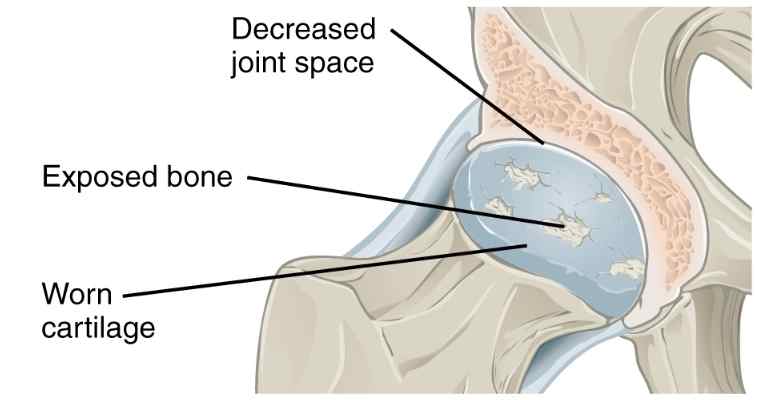by Connor Hulme, SPT

By CFCF – Own work, CC BY-SA 4.0, https://commons.wikimedia.org/w/index.php?curid=44235706
Can physical therapy for hip osteoarthritis play a role in increasing mobility, while reducing pain and stiffness?
What is Osteoarthritis?
Osteoarthritis (OA) is the most common type of arthritis, which occurs when the protective cartilage that surrounds joints begins to wear away. This reduction in protective tissue results in decreased joint space and can lead to decreased range of motion (ROM) and muscle weakness. Osteoarthritis is the most common cause of hip pain in individuals >50 years old. This chronic condition is also known as degenerative joint disease and is more likely to develop as people get older.
What Are The Risk Factors?
- Age
- Obesity
- History of developmental disorders
- Decreased hip internal rotation
- Previous hip injury
Clinical Presentation
- Groin, lateral hip, medial thigh pain
- Morning stiffness
- Loss of ROM, most pronounced with hip internal rotation
- Antalgic gait pattern
- Pain with weight bearing activity
- Decreased hip strength
Physical Performance Measures
- 6-minute walk test
- 30 second chair-stand test
- Stair measure
- Timed up and go
Physical Therapy Treatment
Pain management / patient education: It is important for physical therapists to include other health care professionals to maximize patient outcomes. This could include referrals to physicians, nutritionists, or dieticians to support weight loss program. The educational component of treatment might also include ways of offloading the arthritic side as means of pain relief. See our Case Study on hip pain here)
Manual therapy: Joint and soft tissue mobilizations are utilized to address both muscular restrictions and joint malposition. When addressing hip OA, these techniques will include soft tissue mobilizations such as stretching of piriformis and iliopsoas, psoas release, and instrument assisted soft tissue mobilizations (IASTM). Other techniques will include joint mobilizations such as hip distractions, and hip anterior and posterior glides to improve ROM. Manual therapy will also consider stretching of the piriformis and iliopsoas.
Therapeutic exercise: This intervention strategy helps physical therapists address limitations of mobility and stability of the hip. Treatment will begin with active range of motion exercise to regain lost mobility. Once the hip joint demonstrates adequate ROM, treatment will then progress to strengthening of the hip external rotators, extensors, and abductors.
Gait/Balance training: It is important to consider the proper use of an assistive device for patients having difficulty with weight bearing due to pain, ROM deficits and joint stiffness/instability.
Home exercise program (HEP): Bridging, clam shells, knee to chest, hip abduction and stretching to hip flexors and the piriformis are all appropriate exercises when treating hip OA. Each exercise can be modified to either increase or decrease in difficulty based on the patient’s tolerance to activity.
Surgical approach: Both the anterior and posterior approach of a total hip arthroplasty are common surgical procedures used to treat osteoarthritis, which helps address pain and loss of function. It is important for physical therapists to educate patients on hip precautions following surgical procedure to emphasize patient safety and to minimize the chance of hip dislocation.
Learn more about hip osteoarthritis and how PT can help. Contact us to at one of our Capital Area Physical Therapy & Wellness. clinics in Malta – Saratoga Springs or Queensbury – Glens Falls at (518) 502-1154 to schedule an appointment!
References:
1. Bremer A, Kalberer F, Pfirrmann C, et al. Soft tissue changes in hip abductor muscles and tendons after total hip replacement. The Journal of Bone and Joint Surgery. 2011; 93:886-889.
2. Cibulka M, Bloom N, Enseki K, et al. Hip pain and mobility deficits – hip osteoarthritis: revision 2017. J Orthop Sports Phys Ther. 2017;47(6):A1-A37.
3. Higgins B, Barlow D, Heagerty N, et al. Anterior vs. posterior approach for total hip arthroplasty, a systematic review and meta-analysis. The Journal of Arthroplasty. 2015; 30:419-434.





